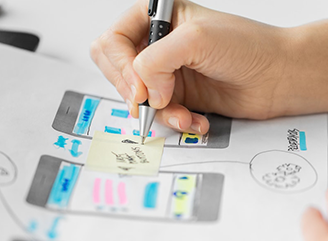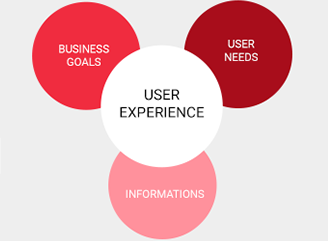UI vs UX – What’s the Difference?
What’s the difference between UI and UX? It’s a common question asked across the Internet and for good reason. The answer is a bit confusing and the elements work in a symbiotic relationship to entice website visitors to take action. However, a lot of people use these terms interchangeably when they shouldn’t. While there are a lot of ways that UI and UX work together, at the core they’re quite different. In this article, we’ll work to answer the age-old question: UI versus UX—what’s the difference?
What is User Interface (UI)?

User Interface is centered on how a website looks. It’s the backend work that’s done to make a website appealing to your visitors through beautiful design elements and aesthetics. It works to compliment UX through current trends and best practices for design elements. It encompasses a number of different elements from how the content is viewed, graphic design elements, lists, and more. UI is essentially the link between your website and your visitors. It’s the ever-evolving relationship between a person and the system they’re using.
User Interface is tricky and takes a lot of practice. A good UI designer will be able to connect with the visitor’s emotions and therefore give them a reason to stick around on the site and become loyal to your brand. It takes into account typography, placement, and alignment. UI needs to make something appealing to the eye so that more action is taken.
At the core of things, User Interface is about how the website looks, not necessarily how it operates. However, you can’t exactly have a functioning website that simply looks nice. That’s why UX is important.
What is User Experience (UX)?

User Experience isn’t really about how your site looks; it’s about how it functions. Yes, you’ll need a specific type of UI to achieve your desired UX, but UX is much more than that. It focuses on how your visitors actually interact with your page, not how they feel when they see it. To make sure that you’re achieving the most successful UX, you’ll need to do a lot of research. You need to understand how your target audience thinks, what compels them to take action, and how they behave on a daily basis. Knowing this will help you formulate an online experience that will get people to take action. More often than not, UX occurs well before UI is even considered. UX focuses on all of your visitor’s interactions with your website and how to best drive conversions.
One of the primary aspects of UX is ease of use. Is your website or page easy to navigate for your target audience? Are there interface elements that encourage conversions? What drives people to follow through with your calls to action? User Experience includes usability, profiling, asking for permissions like push notifications, form and function, simplicity, and ease of use.
Again, at the core of things, User Experience is about how the website or app actually operates, not how it looks. It’s geared around making sure that your visitors have a good experience when they’re on your website.
How do UI and UX Work Together?
After reading about both UI and UX independently, it comes as no surprise that the two work together. You need to have a good UI to have a good UX. The research done through UX development will then translate to how you can best use UI to meet your end goals. You can’t really have one without the other, unless you create a website that looks pretty, but does nothing, or a website that does everything, but is viewed in code. Hopefully, understanding each of the two separately paints a better picture of how they work together. If you’re still a bit confused, let’s explore how they’re different.
What’s The Difference Between UI vs. UX?

One thing that needs to be stressed is that UI and UX are integrated. User Experience is made up of a ton of moving parts—including User Interface. With that being said, you can’t have User Experience without User Interface, but you can have User Interface without focusing on User Experience. UI is what helps you achieve a sound UX, but it’s only one piece of the puzzle. To explain this further, here are some of the primary differences of UI vs. UX.
1. Underlying Functionality
One of the main differences between UI and UX is their underlying function. User Interface is used to uphold a certain standard of quality and beauty in web design. UI is strictly aesthetic in functionality. It is what makes a website attractive and helps to draw users in with design elements. UI changes based on market trends and covers everything from color scheme, on-page images or media, font choices and more. The goal is to make a page appealing to a visitor, simple to use, and fairly straightforward. Most of the design elements used in UI is based on UX, so the two need to compliment each other for the most successful result—more conversions. To get the most out of your UI, you should implement easily navigable menus, a simple, yet beautiful design, consistency across web pages, easy communication channels, and a bold typography.
User Experience therefore functions as a guideline to how a website or page needs to be designed. It uses market research to see the trends of visitors to a site and how they react to certain market trends. UX can be seen as the preliminary stages for UI. It involves analyzing behaviors of target audiences, developing ideal personas of a typical visitor, and then seeing how they react to changes in a website’s design. UX focuses on how someone feels during the interaction on a website and what will most entice them to take action. It gives direction to the flow of a website and without it, people would be lost and ultimately leave your site without taking any action.
2. Connecting to Emotions vs. Goals
Just as UI and UX differ in underlying functionality, the type of connection they form with visitors to your website will be different. When someone first arrives on your page, they will instantly feel either connected or disassociated from your site. The colors, branding, images, navigation, and layout will either connect them on an emotional basis or turn them away. UI works to design a page based on forming an emotional connection with your visitors. It’s almost like creating an online personality for your site. It’s what gets people to connect and hopefully, stick around.
User Experience is the process of identifying what resonates with your visitors enough to get them to take action. It focuses on outlining what the most important attribute to them and how your site can communicate that. Again, it includes observation, trial-and-error, analyzing, and lots of testing. It focuses on what your specific target audience needs on a website to take action. Once that’s determined, it is made apparent through UI and other features. UI works to connect to your visitor’s emotions, while UX connects to the underlying goals or intent that they have when visiting your site.
3. How They’re Done
In most cases, UX is done first. This is because it takes a lot of research about your target audience to determine how to successfully implement UX. To avoid wasting time, and effort, research is crucial. This research will help guide overall development along with the underlying UI when the time comes. Once research is done, a designer will come in and compliment the research with aesthetically pleasing elements that help connect with the underlying emotions that will drive conversions. However, in some cases this process is a bit messy. Sometimes, the same person develops UX and UI simultaneously, which produces it’s own hurdles. Both UX and UI need research to back their development.
Looking at User Experience and User Interface is easier when you look at how they work together. They function as collaborative efforts to meet the same goal: create a website that your visitor’s enjoy that produces high conversion rates.
At the end of the day, UI and UX are counterparts. It’s difficult to definitively say what their underlying differences are because they work in harmony, however they encompass very different elements that should be developed individually. UX is about how your website, app, or platform feels to a visitor on a whole; UI is about how it looks. When you master both UI and UX, you’ll be able to deliver results that further your business’ bottom line. If you need help developing your website’s User Interface (UI) or User Experience (UX), contact the professionals at Plego Technologies today.
